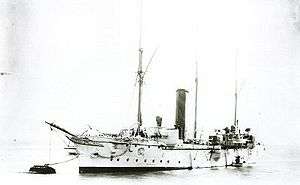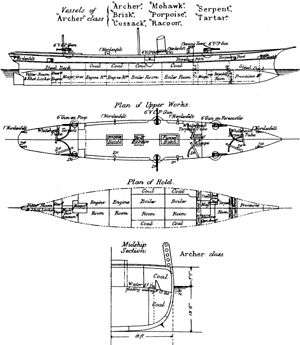HMS Serpent (1887)
 | |
| History | |
|---|---|
| Name: | HMS Serpent |
| Builder: | Devonport Dockyard |
| Laid down: | 9 November 1885 |
| Launched: | 10 March 1887 |
| Completed: | March 1888 |
| Status: | Sunk 10 November 1890 |
| General characteristics | |
| Class and type: | Archer-class torpedo cruiser |
| Displacement: |
|
| Length: | 240 ft (73.15 m) oa |
| Beam: | 36 ft (10.97 m) |
| Draught: | 14 ft 6 in (4.42 m) |
| Installed power: | 4,500 ihp (3,400 kW) |
| Propulsion: |
|
| Speed: | 17.5 kn (32.4 km/h) |
| Range: | 7,000 nmi (13,000 km) |
| Complement: | 176 men |
| Armament: |
|
| Armour: |
|
HMS Serpent, was an Archer-class torpedo cruiser of the Royal Navy. Serpent was built at Devonport Dockyard, entering service in 1888. She was lost when she ran aground off Cape Vilan in northwest Spain with the loss of all but three of her crew.
Construction
Serpent was laid down at Devonport Dockyard on 9 November 1885 as a member of the Archer-class of torpedo cruisers, was launched on 10 March 1887 and completed in March 1888.[1]
Torpedo cruisers were small, relatively fast, ships intended to defend the fleet against attacks by hostile torpedo boats, while themselves being capable of attacking hostile fleets with torpedoes. The Archer class were enlarged derivatives of the earlier Scout-class, which carried a heavier armament.[2]
Serpent was 240-foot (73.15 m) long overall and 225-foot (68.58 m) between perpendiculars, with a beam of 36-foot (10.97 m) and a draught of 14-foot-6-inch (4.42 m). Displacement was 1,770 long tons (1,800 t) normal and 1,950 long tons (1,980 t) full load.[1] The ship's machinery, built by Harland and Wolff,[3] consisted of two horizontal compound steam engines rated at 4,500 indicated horsepower (3,400 kW), which were fed by four boilers and drove two shafts for a speed of 17.5 knots (32.4 km/h; 20.1 mph).[1] 475 tons of coal were carried, sufficient to give a range of 7,000 nautical miles (13,000 km; 8,100 mi),[3] and three masts were fitted.[1]

Armament consisted of six 6-inch (5 ton) guns, backed up by eight 3-pounder QF guns and two machine guns. Three 14-inch torpedo tubes completed the ship's armament. Armour consisted of a 3⁄8 inch (10 mm) deck, with 1 inch (25 mm) gunshields and 3 inches (76 mm) protecting the ship's conning tower. The ship had a complement of 176 officers and ratings.[1]
Service
Serpent took part in the 1888 Fleet manoeuvres, where her machinery proved unreliable and in the 1889 manoeuvres.[3] On 8 November 1890, Serpent left Devonport to relieve the sloop Acorn on the West African Station.[3] On the night of 10 November, Serpent was caught in a heavy storm in the Bay of Biscay and attempted to reach shelter, but ran aground on Cape Vilan near the village of Camariñas in Galicia, northwest Spain. All but three of her crew were killed.[3][4] The resulting court martial investigating the cause of the loss of Serpent concluded that the ship had been lost as a result of a navigation error.[5]
Citations
- 1 2 3 4 5 Chesneau and Kolesnik 1979, p. 81.
- ↑ Chesneau and Kolesnik 1979, pp. 80–81.
- 1 2 3 4 5 "The Loss of H.M.S Serpent" (PDF). The Engineer. 14 November 1890. p. 398.
- ↑ "Aniversario del naufragio del "HMS Serpent"". El Ideal Gallego. 8 February 2015. Retrieved 2 October 2015.
- ↑ Clowes 1903, p. 400.
References
- Chesneau, Roger; Kolesnik, Eugene M, eds. (1979). Conway's All The World's Fighting Ships 1860–1905. London: Conway Maritime Press. ISBN 0-85177-133-5.
- Clowes, William Laird (1903). The Royal Navy: A History From the Earliest Times to the Death of Queen Victoria: Volume VII. Sampson Low, Marston and Company.